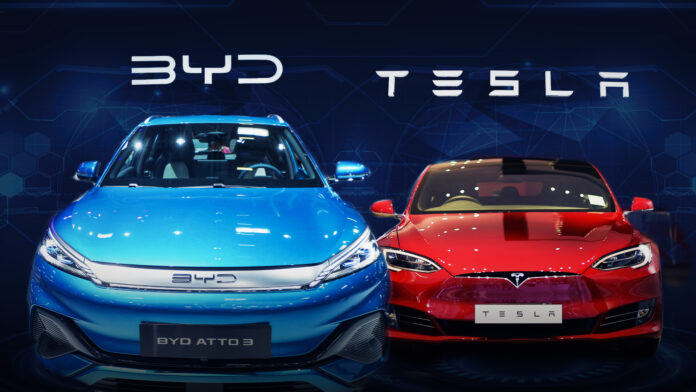BYD, the Chinese electric vehicle giant, is making bold moves that could disrupt the U.S. auto industry and intensify competition with established players like Tesla, Ford, and General Motors.
According to recent reports, BYD is considering building a car assembly plant in Mexico, a strategic move that would allow the company to crack the lucrative North American market. This development has significant implications for the U.S. electric vehicle landscape and raises questions about how long industry leaders have to prepare for the arrival of a formidable new competitor.
A Plant in Mexico: A Gateway to the U.S. Market
The possibility of a BYD plant in Mexico is a big deal, and it should serve as a wake-up call for companies like Tesla, Ford, and GM. While these automakers have time to prepare, industry analysts suggest that they should start getting ready now.
Edison Yu, a Deutsche Bank analyst, recently wrote a report stating that BYD is eyeing the Nuevo Leon and Bajio regions in Mexico as potential locations for its new plant. Interestingly, Nuevo Leon is also the site where Tesla is currently constructing a new factory.
BYD’s spokesperson did not disclose the specific location under consideration, but the company’s interest in establishing a presence in Mexico is clear. It would provide BYD with a strategic foothold in North America, allowing the company to circumvent the 25% tariff on Chinese car imports into the United States.
Exporting BYD vehicles directly from China to the U.S. market is not a viable option due to the high tariffs. If BYD were to cut prices to offset the tariff, the estimated loss per car would be in the range of $4,000 to $5,000, excluding shipping costs. This makes local production in a country like Mexico, which has more favorable trade agreements with the U.S., a necessity for BYD to succeed in the North American market.
A Rapid Expansion Into Overseas Markets
BYD’s ambitions in the U.S. market come on the heels of its rapid expansion into overseas markets. In 2023, the company delivered 243,000 units across 70 countries, accounting for approximately 8% of its total sales of over 3 million vehicles.
While BYD has not yet entered the U.S. market, its impressive growth in China and other countries demonstrates its potential to become a significant player in the global electric vehicle industry.
Learning from Toyota’s Playbook
To understand how BYD might approach the U.S. market, it’s worth examining Toyota’s path to success in North America. Toyota began selling cars in the U.S. in 1958, moving a modest 258 vehicles that year. By 1963, the company had established 125 dealerships.
In the early years, Toyota’s presence was not a significant threat to the domestic industry, as the company’s U.S. market share entering the 1970s was around 1%. Toyota made its first manufacturing investments in the U.S. in 1972 and 1974, and in 1984, the company formed a joint venture with GM that would later become the Fremont, California plant now owned by Tesla.
Toyota’s U.S. market share increased by approximately 6 percentage points through its manufacturing expansions in the 1970s and 1980s. Today, Toyota has 13 plants in North America, including eight vehicle assembly operations. In 2023, Toyota sold 2.2 million cars in North America and held about 14% of the U.S. market.
It took Toyota about 20 years for its market share gains to significantly impact the results of domestic automakers after establishing U.S. manufacturing capacity. However, in today’s fast-paced business environment, things seem to happen more rapidly, so U.S. automakers may have a decade or less to prepare for BYD’s potential entry into the market.
How U.S. Automakers Can Prepare
Preparing for BYD’s potential entry into the U.S. market raises the question of how domestic automakers should respond. BYD is known for producing low-cost battery electric vehicles and plug-in hybrid vehicles profitably, thanks in part to its in-house battery production capabilities.
While U.S. automakers have or are building their own battery capacity, which should help nullify BYD’s advantage in this area, the key to competitive success will ultimately boil down to product offerings.
Domestic automakers need to focus on developing attractive, lower-priced electric vehicles to compete with BYD. Chevrolet’s 2024 Equinox EV, which starts at $35,000, is a step in the right direction and will be available in mid-2024.
Ford is also working on what it calls “gen-two” EVs, which will follow the company’s current “gen-one” vehicles like the Mustang Mach-E and F-150 Lightning. These new models will be optimized for electric technology, unlike the modified gasoline-powered platforms used for the current generation.
One of Ford’s gen-two vehicles will be a smaller, lower-priced EV, aimed at competing with BYD’s offerings. Similarly, Tesla is working on its next vehicle platform, which could include a battery electric vehicle that might start below $30,000. This vehicle could potentially hit the roads as early as 2025.
The sooner these domestic automakers can bring competitive, lower-priced electric vehicles to market, the better prepared they will be to face the potential challenge from BYD.
Conclusion
BYD’s plans to establish a manufacturing presence in Mexico should serve as a wake-up call for Tesla, Ford, GM, and other U.S. automakers. The Chinese electric vehicle giant is rapidly expanding its global footprint and has set its sights on the lucrative North American market.
While domestic automakers have time to prepare for BYD’s potential entry, the window of opportunity may be closing quickly. By studying Toyota’s playbook and focusing on developing attractive, lower-priced electric vehicles, U.S. companies can position themselves to meet the challenge posed by this formidable new competitor.
In the fast-paced world of electric vehicles, the race to dominate the market is heating up, and automakers that fail to adapt risk being left behind.























